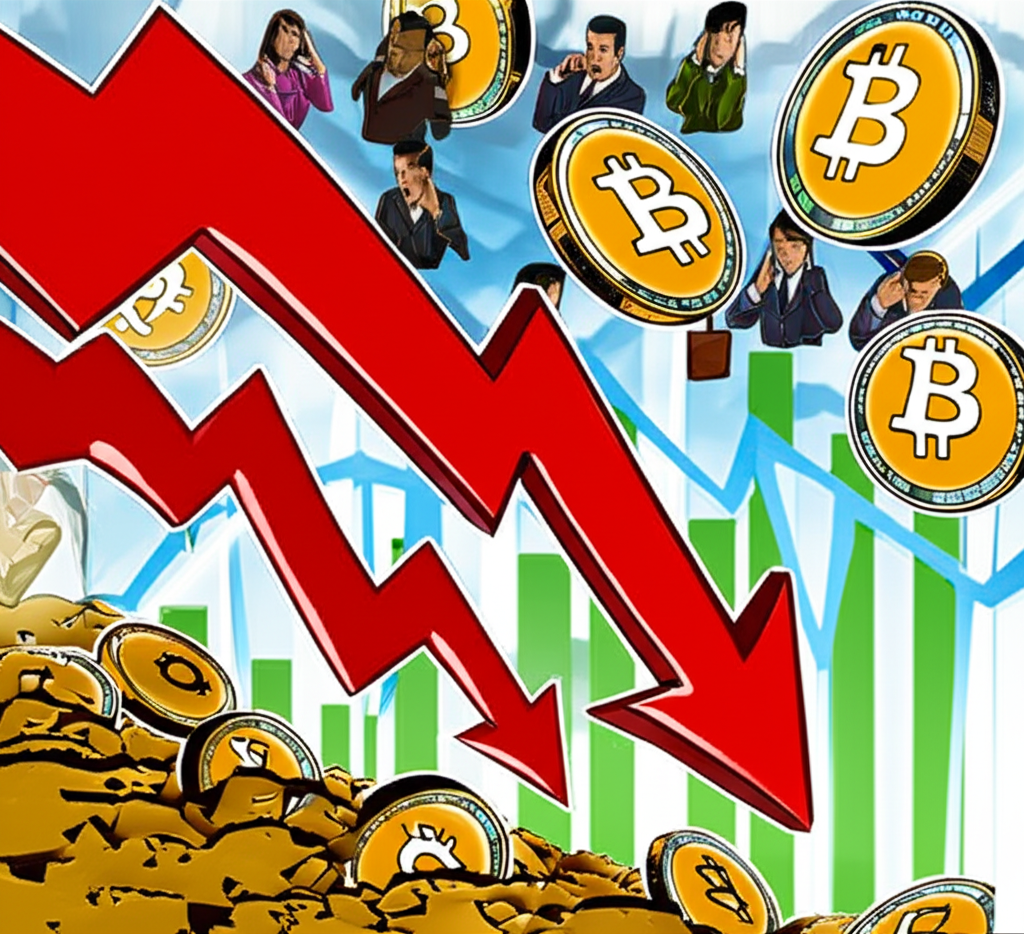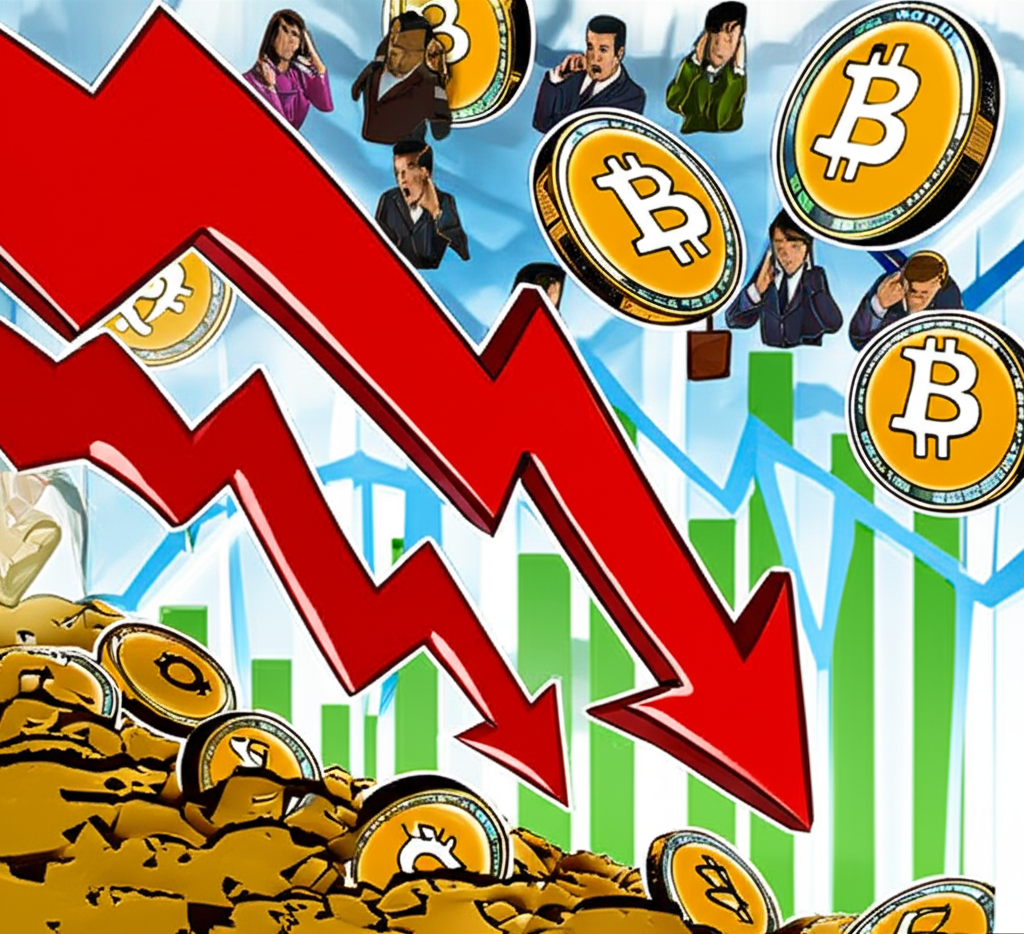Introduction: Demystifying the Cryptocurrency Crash

A sudden and dramatic plunge in cryptocurrency values can shake even the most composed investor. Known as a cryptocurrency crash, this phenomenon involves a swift and severe drop in market prices—often exceeding 50% in a short window. Unlike routine market corrections, which are minor pullbacks following rallies, crashes reflect deeper structural or psychological ruptures in investor confidence. These events don’t just erode wealth; they trigger widespread uncertainty, test technological resilience, and reshape the regulatory landscape. Billions in market capitalization can vanish in days, leaving behind a trail of speculation, fear, and recalibration. This article unpacks the anatomy of a crypto crash, from its root causes and historical precedents to its cascading consequences and long-term implications. By exploring both past patterns and future risks, we aim to equip readers with the insight and foresight needed to navigate volatility with clarity and resilience.
What Triggers a Cryptocurrency Crash? A Multi-faceted Analysis

Cryptocurrency crashes rarely stem from a single event. Instead, they emerge from an intricate web of economic, regulatory, technical, and behavioral forces. Recognizing these interlocking triggers is essential for building durable investment strategies and anticipating systemic stress points before they erupt.
Macroeconomic Headwinds and Global Economic Shifts
Despite their digital and decentralized nature, cryptocurrencies are deeply entwined with traditional financial systems. When inflation surges or central banks like the U.S. Federal Reserve raise interest rates aggressively, capital tends to flee speculative assets in favor of safer holdings such as Treasury bonds or gold. Higher rates increase borrowing costs, reduce liquidity, and elevate the opportunity cost of holding non-yielding assets like Bitcoin or Ethereum. The 2022 bear market offers a clear case study: as the Fed tightened monetary policy to combat inflation, risk assets across equities and crypto tumbled. The correlation between rising interest rates and declining crypto valuations became undeniable. In this environment, digital assets lost their luster as investors prioritized capital preservation over growth potential.
Regulatory Uncertainty and Geopolitical Actions

Government actions and policy shifts can send shockwaves through the crypto ecosystem. Sudden regulatory crackdowns—such as China’s 2021 ban on mining and trading—can trigger massive sell-offs within hours. Similarly, ambiguous legal frameworks or proposals for heavy taxation create uncertainty, discouraging institutional participation and retail adoption alike. Geopolitical tensions also play a role. Trade disputes, sanctions, or international conflicts heighten global risk aversion, prompting investors to exit volatile markets. For example, escalating U.S.-China trade tensions during the “Trump tariffs” era contributed to broader market instability, indirectly affecting crypto sentiment. As highlighted in a detailed analysis by the **World Economic Forum**, geopolitical dynamics are increasingly shaping the trajectory of digital assets, influencing everything from investor behavior to innovation pathways here.
Technical Vulnerabilities and Project-Specific Failures
The crypto space, still in its formative years, remains vulnerable to technical flaws and operational failures. Smart contracts—self-executing code that powers DeFi applications—are only as secure as their programming. Exploits due to coding errors have led to hundreds of millions in losses, shaking trust in entire platforms. High-profile hacks, such as those targeting Mt. Gox, Coincheck, and more recently, Wormhole and Nomad, underscore the persistent security challenges. Perhaps most devastating are collapses rooted in flawed economic design. The Terra/Luna crisis in May 2022 exemplifies how a single project’s failure can trigger systemic contagion. Its algorithmic stablecoin, UST, lost its peg amid a liquidity run, wiping out over $40 billion in value and dragging down related protocols, lenders, and exchanges. Such events expose the fragility of interconnected systems built on unproven models.
Market Manipulation, Whale Activity, and Liquidation Cascades
Due to lower liquidity and limited oversight compared to traditional markets, crypto is susceptible to manipulation. Large holders—commonly known as “whales”—can influence prices by executing coordinated sell-offs or spreading misinformation. These actions often spark panic among smaller investors, accelerating downward momentum. Another amplifier is the use of leverage. Many traders borrow funds to magnify returns, but when prices fall sharply, their positions face automatic liquidation. This forced selling fuels a feedback loop: falling prices trigger more liquidations, which push prices even lower. Known as a *liquidation cascade*, this mechanism can turn a modest correction into a full-blown crash within minutes. During the May 2021 downturn, billions in leveraged positions were wiped out in hours, demonstrating how fragile over-leveraged markets can be.
Investor Sentiment, Fear, and Behavioral Economics
At its core, market movement reflects collective psychology. During bull runs, fear of missing out (FOMO) drives irrational exuberance, inflating valuations beyond fundamental justification. This creates bubbles fueled more by emotion than utility. Conversely, when sentiment shifts, fear takes over. As prices fall, investors often sell impulsively to avoid further losses, even if fundamentals remain intact. This herd mentality deepens the slide, turning temporary dips into prolonged bear markets. Behavioral economics shows that humans are wired to feel losses more acutely than gains—a phenomenon known as loss aversion. In crypto, where price swings are extreme, emotional decision-making becomes a key catalyst of downturns, often outweighing rational analysis.
A Historical Perspective: Notable Cryptocurrency Crashes and Their Legacies
History doesn’t repeat itself exactly—but it often rhymes. Examining past crashes reveals recurring themes: speculation, overreach, regulatory pressure, and human psychology. Each downturn has left lasting lessons, shaping how investors, developers, and regulators approach the space today.
The 2017-2018 “Crypto Winter” and ICO Bubble Burst
The year 2017 was a spectacle of unprecedented growth. Bitcoin surged past $19,000, while countless altcoins exploded in value amid a frenzy of Initial Coin Offerings (ICOs). Startups raised millions with little more than whitepapers, and retail investors poured money into projects without due diligence. By early 2018, reality set in. Most ICOs delivered nothing of value. Regulatory scrutiny intensified. Confidence eroded. Prices collapsed—many assets lost 80–90% of their value and stayed depressed for over a year. This period, dubbed “crypto winter,” served as a sobering reset. It exposed the dangers of unchecked speculation and emphasized the need for solid fundamentals, transparency, and long-term vision in blockchain development.
The 2021 May Flash Crash and China’s Crypto Crackdown
After a strong rally in early 2021, driven by growing acceptance from institutions like Tesla and Square, the market abruptly reversed in May. Within days, Bitcoin dropped nearly 50% from its all-time high. A primary catalyst was China’s renewed crackdown on cryptocurrency mining and trading activities. The government banned financial institutions from offering crypto services and ordered miners to shut down operations. Given China’s dominant role in mining at the time, the news triggered panic. However, unlike previous downturns, recovery came swiftly. By late 2021, major cryptocurrencies had rebounded, signaling increasing market maturity and resilience to geopolitical shocks.
The Terra/Luna and FTX Debacles (2022): Systemic Risks Exposed
2022 became a defining year for systemic risk in crypto. First came the implosion of Terraform Labs’ ecosystem. The algorithmic stablecoin UST, designed to maintain a $1 peg through complex incentives, failed spectacularly under redemption pressure. As UST de-pegged, panic spread, and LUNA—the token meant to absorb volatility—collapsed from over $80 to fractions of a cent. Billions vanished overnight. The fallout extended far beyond Terra: lending platforms like Celsius and Voyager Digital froze withdrawals, hedge funds faced insolvency, and confidence in algorithmic stability mechanisms evaporated.
Months later, the fall of FTX delivered another body blow. Once hailed as a trusted global exchange, FTX collapsed after revelations that customer funds had been misused to support its sister trading firm, Alameda Research. The exchange filed for bankruptcy, wiping out billions in user assets. This event shattered trust in centralized custodians and highlighted the urgent need for audits, transparency, and regulatory safeguards. As **Bloomberg** documented, the contagion rippled across markets, triggering liquidations, exchange withdrawals, and a broader loss of faith in the industry’s integrity here.
Analyzing Speculative 2025 Crash Scenarios and Forward-Looking Lessons
While no one can predict the exact timing or trigger of the next crash, forward-looking analysis helps investors prepare. Potential scenarios for 2025 might include synchronized global recessions, aggressive regulatory clampdowns in major economies like the U.S. or EU, or unforeseen technological threats such as advances in quantum computing undermining cryptographic security. Alternatively, a surge in unregulated DeFi derivatives could create hidden leverage bubbles ready to burst. The key takeaway from past crises is clear: resilience comes from preparation. Projects with transparent governance, audited code, and sustainable tokenomics are more likely to survive. Investors who diversify, avoid over-leverage, and stay informed will be better positioned to weather future storms.
The Far-Reaching Impacts of a Crypto Crash
A crypto crash extends far beyond price charts. Its effects ripple through individual lives, institutional balance sheets, technological progress, and public perception.
Financial Losses and Psychological Toll on Investors
The most immediate consequence is financial devastation. Individuals who invested life savings, borrowed funds, or quit jobs to go “all in” on crypto can face ruin when markets collapse. But beyond monetary loss lies a profound emotional burden. Watching years of gains vanish in weeks breeds anxiety, regret, and sometimes depression. The psychological weight of loss often leads to poor decisions—selling at the bottom, abandoning strategies prematurely, or exiting the space entirely. This emotional spiral not only harms individuals but also reinforces negative cycles in the market.
Broader Market Contagion and Ecosystem Effects
Crypto markets are tightly interconnected. A failure in one sector often spills over into others. When Terra collapsed, DeFi protocols relying on UST suffered massive de-pegging events and liquidity crunches. NFT markets, closely tied to Ethereum’s health and speculative sentiment, saw trading volumes plummet by over 90% in some cases. Venture capital funding dried up, startups laid off staff, and development slowed across the board. Even blockchain gaming and metaverse projects felt the chill. This domino effect illustrates how fragile ecosystem-wide stability can be when built on interdependence without sufficient risk buffers.
Increased Regulatory Scrutiny and Innovation Setbacks
Major crashes inevitably draw regulatory attention. In the wake of Terra and FTX, lawmakers worldwide called for tighter oversight. While reasonable regulation can enhance transparency and protect consumers, poorly designed rules may stifle innovation. Overly restrictive licensing requirements, unclear tax treatments, or outright bans could push development underground or offshore, reducing accountability without eliminating risk. Striking a balance between investor protection and fostering technological advancement remains one of the greatest challenges facing policymakers in the digital asset era.
Navigating the Storm: Strategies for Resilience and Recovery
Crashes are inevitable in high-volatility markets. But preparation, discipline, and strategy can transform crisis into opportunity.
Robust Risk Management and Portfolio Diversification
The foundation of any sound investment approach is risk management. Investors should never commit more capital than they can afford to lose. Assessing personal risk tolerance—whether conservative, moderate, or aggressive—is critical before entering the market. Diversification remains one of the most effective tools for mitigating exposure. Spreading investments across different cryptocurrencies, sectors (e.g., DeFi, layer-1 blockchains, privacy coins), and asset classes reduces reliance on any single point of failure. Holding a mix of digital assets alongside traditional investments like stocks, bonds, or real estate provides a buffer during turbulent times.
Dollar-Cost Averaging (DCA) and the Long-Term HODLing Philosophy
Timing the market is notoriously difficult—even for professionals. Dollar-cost averaging (DCA) offers a disciplined alternative: investing fixed amounts at regular intervals, regardless of price. This method smooths out purchase costs over time and removes emotion from entry decisions. During a crash, DCA allows investors to accumulate assets at lower prices, positioning them advantageously for recovery. Pairing this with a long-term “HODL” mindset—holding through volatility based on belief in underlying technology and adoption trends—can yield strong returns over multi-year cycles. Many early Bitcoin adopters owe their success not to perfect timing, but to unwavering patience.
Advanced Hedging Strategies and Derivatives for Risk Mitigation
For experienced investors, hedging offers another layer of protection. Financial instruments like options and futures enable downside risk control. Buying put options, for instance, grants the right to sell an asset at a predetermined price, effectively capping potential losses. Shorting futures contracts can offset losses in spot holdings during downturns. While these tools require knowledge and carry risks—including counterparty exposure and margin calls—they allow sophisticated investors to express nuanced views on market direction and manage volatility more actively.
The Importance of Continuous Education and Emotional Discipline
In a fast-moving space like crypto, staying informed is non-negotiable. Understanding blockchain fundamentals, tracking macroeconomic indicators, and monitoring regulatory developments empower smarter decisions. Just as important is emotional discipline. Markets thrive on fear and greed—those who let emotions drive trades often pay the price. Establishing a clear investment thesis, setting predefined rules for entry and exit, and avoiding impulsive reactions during turbulence are hallmarks of successful long-term participants. Reading project whitepapers, analyzing on-chain data, and engaging with communities can foster confidence and reduce reactionary behavior.
The Future of Crypto: Volatility, Maturation, and Adaptive Strategies
The path forward for cryptocurrency is neither linear nor guaranteed. Yet, clear trends point toward greater integration, resilience, and institutional involvement—even amid ongoing volatility.
Inevitable Volatility as a Feature of Emerging Markets
Volatility is not a bug—it’s a feature of nascent markets. Cryptocurrencies are still evolving, with price discovery influenced by retail sentiment, technological breakthroughs, regulatory shifts, and macroeconomic currents. Boom-and-bust cycles have characterized every transformative technology, from railroads to the internet. Accepting volatility as part of the journey allows investors to focus on long-term value creation rather than short-term noise. Those who understand this are better equipped to endure downturns and benefit from eventual rebounds.
Towards Greater Stability and Institutional Integration
Despite its wild swings, the crypto market is maturing. Institutional players—hedge funds, asset managers, pension funds—are entering with increasing confidence. Companies like BlackRock, Fidelity, and Galaxy Digital have launched crypto funds or custody services, signaling growing legitimacy. These entities bring not just capital, but also risk frameworks, compliance practices, and long-term horizons that can stabilize markets. Regulatory clarity in jurisdictions like Singapore, Switzerland, and increasingly the U.S. and EU also supports sustainable growth. Meanwhile, improvements in scalability (e.g., Ethereum’s upgrades), security protocols, and cross-chain interoperability strengthen the underlying infrastructure. As **Coinbase** outlines in its institutional research reports, enterprise adoption and regulatory maturation are laying the groundwork for broader financial integration here.
Emerging Technologies and Novel Crash Triggers
With innovation comes new risks. The rise of complex DeFi protocols, synthetic assets, and algorithmic stablecoins introduces layers of financial engineering that may not be fully stress-tested. A single flaw in a widely used protocol could cascade across platforms. Additionally, future technologies like quantum computing pose theoretical threats to current cryptographic standards, though post-quantum cryptography research is underway. As the ecosystem evolves, investors must remain vigilant, continuously evaluating emerging risks and adapting strategies accordingly. Complacency in the face of complexity can be costly.
Conclusion: Building Resilience in a Dynamic Market
Cryptocurrency crashes are dramatic, often painful events—but they are also inherent to the lifecycle of an emerging asset class. Driven by macroeconomic forces, regulatory actions, technical failures, and human psychology, these downturns expose weaknesses while paving the way for stronger foundations. From the ICO bust of 2018 to the Terra and FTX implosions, each crisis has delivered hard lessons about due diligence, transparency, and risk management. The impact extends beyond wallets, affecting innovation, regulation, and public trust. Yet history shows that recovery is possible—and often follows periods of deepest pessimism.
Resilience lies not in avoiding crashes, but in preparing for them. Through diversification, dollar-cost averaging, emotional discipline, and continuous learning, investors can navigate volatility with greater confidence. As institutions deepen their involvement and regulatory frameworks evolve, the market is gradually becoming more robust. Still, volatility will persist, and new risks will emerge. Success in crypto depends not on predicting every downturn, but on cultivating adaptability, patience, and informed judgment. In this ever-changing landscape, knowledge remains the most valuable asset.
1. Why is the crypto market crashing right now?
Cryptocurrency crashes are often triggered by a combination of factors, including global macroeconomic conditions (e.g., high inflation, interest rate hikes), regulatory uncertainty, significant geopolitical events, major project failures or hacks, and shifts in investor sentiment causing panic selling. The specific “right now” causes would depend on current events, so staying informed with

留言